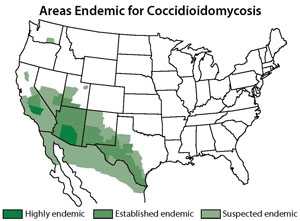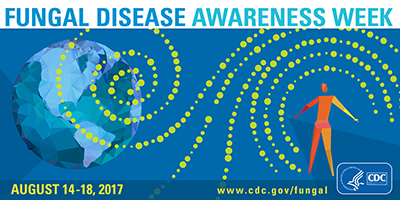Valley Fever Awareness

Valley fever is a fungal lung infection that can be devastating. Learning about Valley fever can help you and your doctor recognize the symptoms early.
Valley fever is an infection caused by a fungus that lives in the soil. About 10,000 U.S. cases are reported each year, mostly from Arizona and California. Valley fever can be misdiagnosed because its symptoms are similar to those of other illnesses. Here are some important things to know about Valley fever, also called coccidioidomycosis.
From soil to lungs
The fungus that causes Valley fever, Coccidioides, is found in the southwestern United States, parts of Mexico and Central America, and parts of South America. The fungus has also been found in south-central Washington State. People can get Valley fever by breathing in the microscopic fungal spores from the air in these areas. Valley fever does not spread from person to person.

Known and suspected areas where the fungus that causes Valley fever lives in the United States
Common symptoms may lead to delayed diagnosis
Many people who are exposed to the fungus never have symptoms. Other people may have flu-like symptoms, including:
- Fatigue (tiredness)
- Cough
- Fever
- Shortness of breath
- Headache
- Night sweats
- Muscle aches or joint pain
- Rash on upper body or legs
The symptoms of Valley fever can be similar to those of other common illnesses, so patients may have delays in getting diagnosed and treated. For many people, symptoms will go away without any treatment, after weeks or months. Healthcare providers prescribe antifungal medication for some people to try to reduce symptoms or prevent the infection from getting worse. People who have severe lung infections or infections that have spread to other parts of the body always need antifungal treatment and may need to stay in the hospital.
People at risk
Valley fever is a serious, costly illness
- Nearly 75% of people with Valley fever miss work or school
- As many as 40% of people who get Valley fever need to stay in the hospital
- The average cost of a hospital stay for a person with Valley fever is almost $50,000
Anyone who lives in or travels to an area where the fungus lives in the environment can get Valley fever. Valley fever can affect people of any age, but it’s most common in adults ages 60 and older. Certain groups of people may be at higher risk for developing the severe forms of Valley fever, such as:
- People who have weakened immune systems, for example, people who:
- Have HIV/AIDS
- Have had an organ transplant
- Are taking medications such as corticosteroids or tumor necrosis factor (TNF) inhibitors
- Pregnant women
- People who have diabetes
- People who are black or Filipino
Awareness is key
In areas where Valley fever is common, it’s difficult to completely avoid exposure to the fungus because it is in the environment. There is no vaccine to prevent infection. That’s why knowing about Valley fever is one of the most important ways to avoid delays in diagnosis and treatment. People who have Valley fever symptoms and live in or have visited an area where the fungus is common should ask their doctor to test them for Valley fever. Healthcare providers should be aware that Valley fever symptoms are similar to those of other respiratory illnesses and should consider testing for Valley fever in patients with flu-like symptoms who live in or have traveled to an area where Coccidioides lives.

Join CDC in sharing information to increase awareness in your community about fungal diseases during Fungal Disease Awareness Week, August 14-18, 2017.
What CDC is doing
- Raising awareness. CDC, state and local health departments, and other agencies are working together to educate the public and healthcare providers about Valley fever to reduce delays in diagnosis and treatment and to improve people’s health outcomes.
- Surveillance. In many states, healthcare providers and laboratories are required to report Valley fever cases to public health authorities. Disease reporting helps government officials and healthcare providers understand why outbreaks occur and allows them to monitor trends in Valley fever cases.
- Advanced molecular detection. CDC has been developing new tools that make it faster and easier to detect Coccidioides in the environment. CDC is also using whole genome sequencing to investigate new areas where Coccidioides is living and causing illness.
- Researching treatment. CDC is assisting other health agencies with studies to understand the best treatment for Valley fever. The National Institutes of Health (NIH) is sponsoring a randomized controlled trial to learn more about Valley fever treatment.
More Information
- CDC – Valley Fever (Coccidioidomycosis)
- CDC – Fungal Diseases
- CDC – Advanced Molecular Detection Projects: Mapping the Range of Valley Fever in the U.S.
- Arizona Department of Health Services – Valley Fever
- California Department of Public Health – Coccidioidomycosis (Valley Fever)
- Valley Fever Center for Excellence
- LA County Department of Public Health—Valley Fever
- LA County Department of Public Health—Valley Fever Youth Flyer [148 KB]
- Page last reviewed: August 11, 2017
- Page last updated: August 11, 2017
- Content source:
- National Center for Emerging and Zoonotic Infectious Diseases
- Page maintained by: Office of the Associate Director for Communication, Digital Media Branch, Division of Public Affairs




 ShareCompartir
ShareCompartir